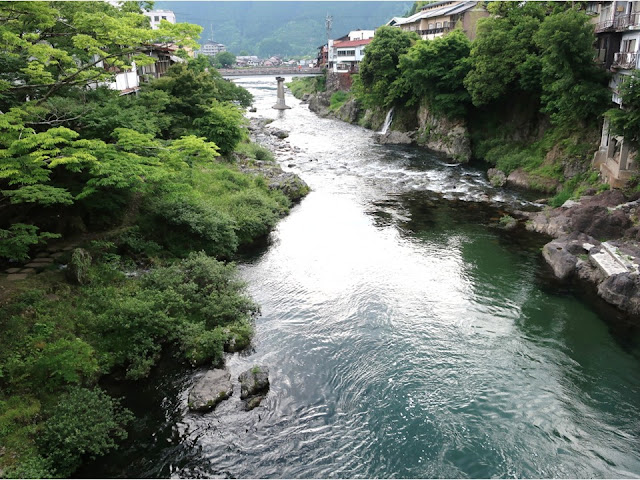The museum is in central Japan (Gujo city in Gifu prefecture). The city is famous for bon festival dance and its pure water. I’d like to show the relationship between water and locals in this article (part 1).
郡上八幡は、三日三晩の徹夜踊り、郡上踊りで有名ですが、長良川上流の水に恵まれた美しい城下町です。川で遊び、川で魚を捕り、川で染物を晒す。水への愛着の強さを感じます。
The organized entrance hall inspires us.
気分があがるエントランスです。
Diving from Shinbashi (bridge) to the pure river; it’s 15 meters height.
新橋からの飛び込み。高さ13mです。
Unhappily, a tourist died due to diving in 2016. The locals discussed prohibition of diving, however, the signboard by the bridge says “A serious accident by diving happened here. We warn an inexperienced person and so on to dive recklessly. -city office- “. It means diving is not prohibited. I totally agree with the thought that a diving is conditionally permitted (understanding the risk) but is not prohibited. The diving is glee in summer for locals; many young people enjoy it.
2016年に飛び込んだ観光客が死亡する事故があり、飛び込み禁止の議論もありました。「この橋からの飛び込みで重大な事故が発生しています。不慣れな方等の無謀な飛び込みは厳に自粛されるように警告します。ー郡上市ー」と看板に書かれていますが、今も、飛び込めます。危険だから禁止ではなく、危険を知った上で楽しむ、遊ぶという考え方に大賛成です。
Water and Culture、水と文化
It is written, “Gujo is a water city” and “We can hear the sound of water everywhere in this city”. Rivers flow in the city; underground water gushes and flows into channels. Its annual precipitation is 2800mm, which is 1.6 times as much as average value in Japan.
「郡上八幡は水のまち」「どこでも水の音が聞こえます」と書かれています。川が流れ、湧き水、水路がある街です。年間降水量は2800mm、全国平均の1.6倍です。
Locals wash foods in the watering-places, on the other hand, dye shops have their rinsing places. The water place inside the yellow dot line is called “Sogi Spring”.
水場は洗い場であり、染め物を晒す仕事場でもあります。渡辺染物店の前の水路では、職人さんが藍染めを晒していました。黄色い枠内は宗祇水です。
“Sogi” is the name of the initiator of Renga poetry. He (1469-1486) lived beside the spring and used the water. There are open tanks in front of the spring.
宗祇水は連歌師・宗祇(1469-1486)がそのほとりに庵を結び湧水を愛用したと観光協会の地図に書かれています。宗祇水の前には水場・洗い場(水舟)があります。
There is an information by the spring. It is a manner while using the spring water; it has been kept for a long time.
立て看板には、引き継がれてきた水利用のルールが書かれています。
In spite of abundant water, drained water is used for the other use again and again (cascading). A resident cleans a watering place by turns.
水は豊富ですが、カスケード利用されています。掃除当番も決められています。
Water makes a relaxing place. I visited the channel in the yellow line.
水は潤いがある場所をつくります。黄色の枠の場所に行きました。
There is a carp in the channel.
確かに。道端で鯉が泳いでいます。
The channel is beside the path above. It is between the private houses. Residents rinse laundry even now. The signboard says, “This small space composed of a canal and walkway is protected and treasured through such efforts by learning from their predecessors and following traditional rules.” It’s a good practice.
いがわ小径と呼ばれ、民家の間を流れる用水に沿った道です。今も、鯉などを飼ったり、洗濯物の濯ぎなどをしています。立て看板には、「人々の協力と、先人達からの知恵や昔ながらのルールに守られながら、愛され、親しまれています」と書かれています。いいですねえ。
Water from Sogi spring flows in the river above. Each house has an approach to the river.
宗祇水が流れ込む小駄良川。どの家からも川へ下りられるようになっています。
It says, “A deity of water is enshrined at a spring, and a festival has been held. Locals follow customs to treat water with respect.”
「湧き水には、水神が祭られ、水を尊ぶ習慣が守られてきました」
Gujo fishermen、郡上八幡の釣り師たち
Four ways to catch ayu fish (sweetfish) are shown. Some catch fishes as job, and others do it as hobby. Sorry to say, volume of fish catches is decreasing recently and number of fishermen is doing as well.
鮎釣の四つの方法が紹介されています。生業として鮎を捕る人、趣味として楽しむ人、様々です。残念ながら、近年は鮎の漁獲量は減少、友釣りの遊漁者も減っています。
Official website: https://hakurankan.com/group_en/
https://hakurankan.com/
(in Japanese, but much info.), accessed in April, 2025
Visited in May, 2024
Previous post (museum in the same city): Meihoh
history and folklore museum、明宝歴史民俗資料館(岐阜県)
Next post (latter half of this article): Gujo-Hachiman Hakurankan (2/2)、郡上八幡博覧館 (part2)
















Comments
Post a Comment